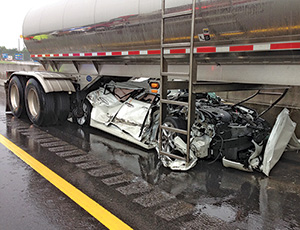
A surge in hydroplane-related wrecks on a recently widened stretch of Interstate 40 has prompted Tennessee Dept. of Transportation officials to meet with representatives of Lane Construction Corp., the design-build contractor, to find a solution.
TDOT started looking at the area near mile marker 226 in Wilson County after local law-enforcement agencies reported an increase in wrecks, especially during wet weather. That segment is part of a $56.5-million design-build widening of I-40 from west of mile marker 226, near state Route 171, to mile marker 232, east of state Route 109.
Mt. Juliet police have responded to nearly 30 crashes-eight with reported injuries-at the same location on I-40 since Jan. 1, says Lt. Tyler Chandler in a community newsletter.
"Almost all of the crashes have the same pattern: heavy rain and same location," Chandler says. "You can clearly see the jump, which began to occur once [the] rainy season hit after the recent construction and redesign."
The number of crashes in the area increased from eight in both 2011 and 2012 to 10 in 2013, 21 in 2014 and 26 through July 12, 2015, according to the Mt. Juliet Police Dept.
None were fatal.
Average daily traffic in that area is 70,950 vehicles.
TDOT managers "reviewed the as-built plans and the Light Detection and Ranging [LiDAR] study to determine any design errors or low-lying areas," says Heather Jensen, TDOT spokeswoman.
"TDOT found the design does not have enough drainage structures and the roadway was built too flat to direct stormwater runoff," she says.
The agency "is working closely with Lane Construction to resolve the issue in a timely manner and to avoid legal action," she says.
A Lane spokeswoman said only that representatives were meeting with TDOT representatives "to discuss their concerns."
TDOT reviewed the Federal Highway Administration's 13 critical elements of design. However, TDOT's review didn't include "locations of catch basins and calculations for storm drains," Jensen says.
But, she points out, "the contractor was responsible for providing design services," including an engineer of record for the project.
There is currently no determination on what can or will be done to solve the problem, and no deadline has been set.
"Things like this are uncommon in new construction," says Matt Cate, technical assistance coordinator at the University of Tennessee Center for Transportation Research.
The widening project "changed the roadway so much ... it changes the drainage characteristics," says Cate, who travels in that area regularly.
John S. Schwartz, associate professor of civil and environmental engineering at the University of Tennessee, says "inadequate design for stormwater drainage is not a common problem."; He continues, "TDOT has a drainage design manual ... and it is quite good."
However, he notes that design-build contracts "can lead to less construction oversight because the design engineer and construction personnel are from the same company. Greater oversight occurs when you have different firms for engineering and construction."
The project, which covered a 6.5-mile segment, called for widening the roadway to eight 12-ft travel lanes-plus a 10-ft paved outside shoulder and 12-ft paved inside shoulder-from four lanes.
The project was the first large design-build highway job in central Tennessee, and the concept was chosen to reduce construction time, TDOT Commissioner John Schroer said in July 2012, when work started.
While completion was originally scheduled for December 2013, Lane got a 154-day extension, to May 15, 2014. The project was actually completed on July 2, 2014, and Lane was fined $594,048 for the delay.

Post a comment to this article
Report Abusive Comment